Hamlet: The Village Building Game - A Solo Review
24 Jun 2023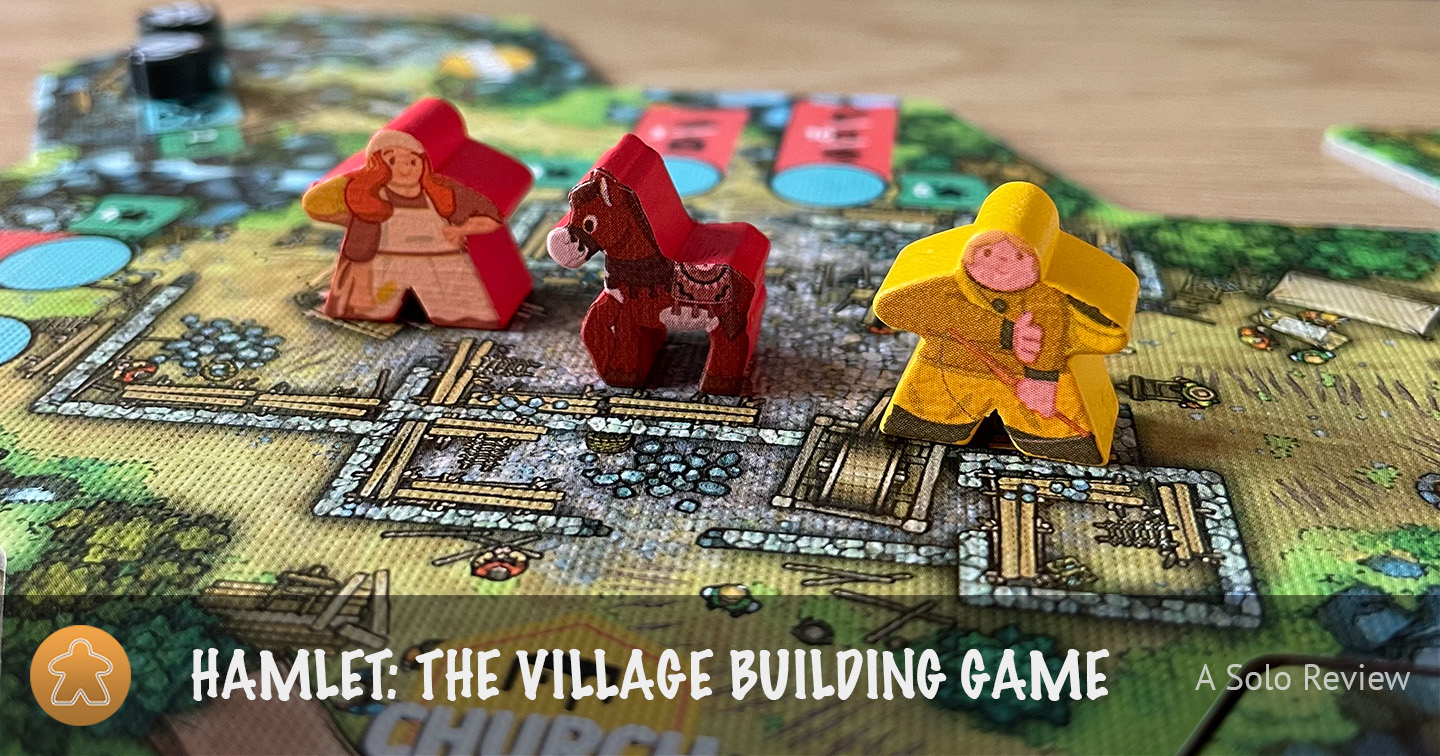
I’ve always been a big fan of video games like The Settlers 3 and Knights and Merchants. In those games you had to build up a village and get a basic economy up and running. Build a woodcutter’s hut so someone could chop down trees. Build a sawmill to turn the logs from the woodcutter into planks. Use the planks to construct more buildings. Watching your villagers transport goods from here to there was so satisfying. When Mighty Boards announced they were creating a board game that looked like it would recreate the feeling of those old video games, they immediately had my interest. Did they succeed? Read on and find out.
Name: Hamlet: The Village Building Game
Designer: David Chircop
Solo designers: Nick Shaw and Dávid Turczi
Publisher: Mighty Boards
Game type: tile placement, network and route building, pick-up and deliver
What is Hamlet: The Village Building Game?
As the name might give away, Hamlet: The Village Building Game is a game in which you are building a village. You start the game with a tiny hamlet (a small village without a church) containing a few tiles, each containing a building: a church building site, a quarry, a woodcutter, a farm, a market and a town hall. By gathering materials and blueprints for more advanced buildings, you can expand the village. These new buildings can, among other things, turn raw materials (wood, wheat and stone) into refined materials (timber, brick, flour and milk) which can then be used to build even more specialized buildings, or make deliveries to the church construction site.
Sounds easy enough, but there are a few twists that make it a bit more interesting than I made it seem. For starters, all materials are shared among the players. When you take an action on the farm to produce wheat, the wheat gets put on the farm and is available for everyone to use. Additionally, the materials need to get transported from the place where they’re produced to the place where they’re going to be consumed. So if you want to turn wood into timber, you need a way to transport wood from the woodcutter to the sawmill. If these building are on adjacent tiles and have a road connecting them, there’s no problem. Materials get transported to an adjacent tile—if there’s a road connecting them!—automatically. If you want to get them transported across a greater distance, not only do you need a continuous road between the two tiles, but you also need to have one of your donkey meeples on each tile in between.
The main goal and timer of the game is constructing the church. The church is constructed piece by piece by making deliveries of money or specific combinations of raw and refined materials. In a solo game, the church needs four different deliveries in order to get it completely constructed. Once all deliveries are made the game ends and whoever has the most points wins.
How does it play?
As usual, let’s go over setup first. As I’ve already mentioned, you start the game with few tiles already laid out. You start with the church building site in the middle. Around that tile you arrange the market, the town hall, the quarry and the woodcutter in any way you like, as long as their roads are connected to the road of the church’s construction site. Next you place two starting materials on the production buildings: two wheat on the farm, two stone on the quarry and two wood on the woodcutter. Prepare the market sales tiles by taking the correct amount of tier 1, tier 2 and tier 3 tiles, stacking them face down in order with the tier 1 tiles on top. Place three tiles face up on the market tile. Fill the cloth bag with all basic buildings, draw four at random and place them above the scoreboard. You start with a villager meeple and a donkey meeple on the church. Botric, the AI opponent, doesn’t use donkeys, so he starts with just a meeple. You also start with some coins; three for you and two for Botric.
For Botric’s components you need his action board and his five action tiles which you place in a random order underneath the board. You also need two action markers in his player color, three in an unused player color and four in another unused player color. One token of each color goes on his action board, the rest in a bag or a cup which does not come with the game.
That’s it for setup.
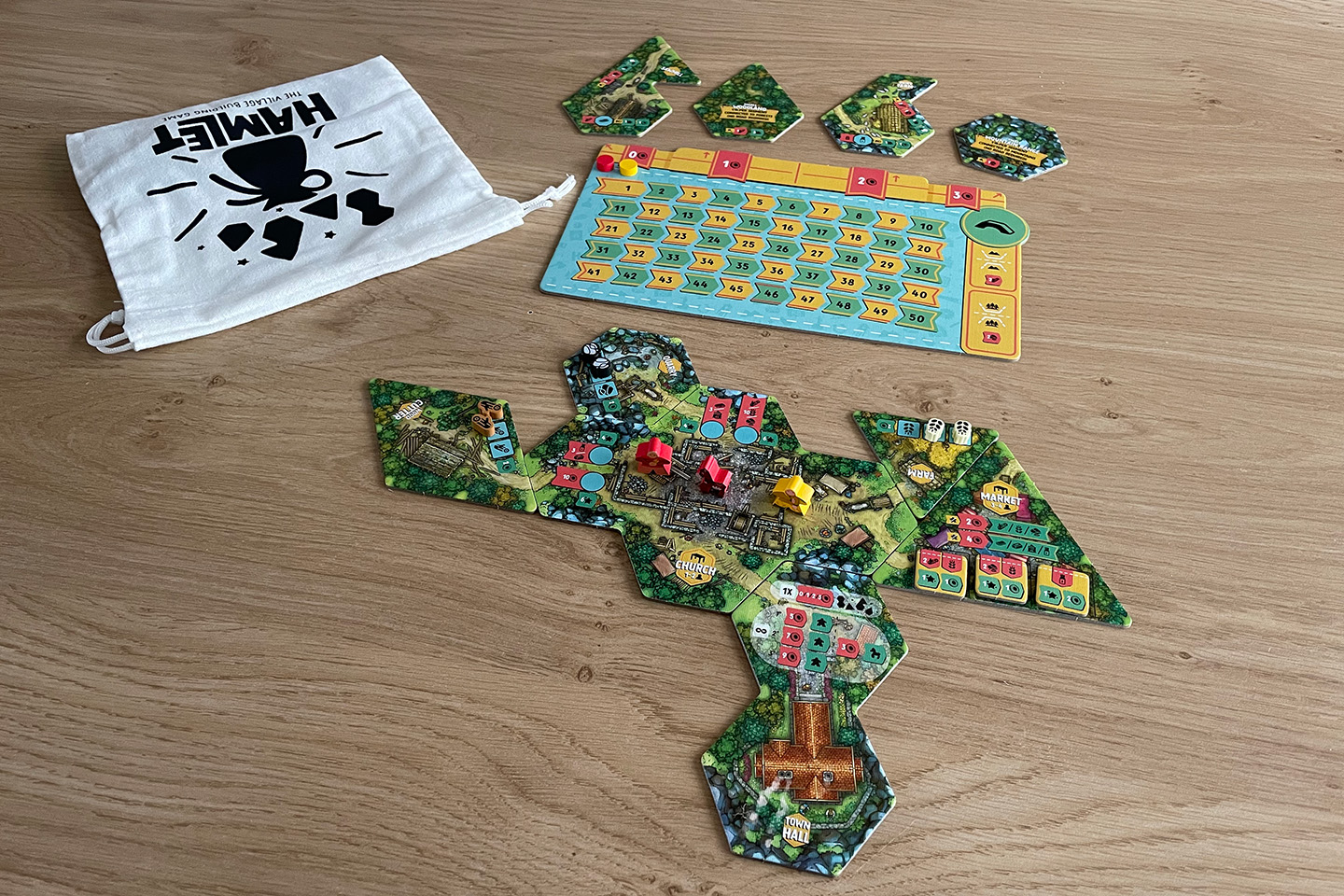
The turn structure is pretty simple since there are only a few things you can do:
- Once per turn you may move each of your donkeys to one adjacent tile. This is optional.
- Move each of your villagers to a tile it can reach by a road and take an action on that tile.
That’s all. Once you have taken an action with all your villagers you turn is over.
The actions you can take take depend on the building a villager is on.
- Produce. This action can be taken on the buildings that produce raw materials, like the woodcutter, the farm and the quarry. Each of those buildings has a few slots to store materials. If any of those spots is empty, activating the building lets you take the materials that building produces from the general supply and fill up all empty spots on the building. This gains you the reward indicated on the building; typically a coin. As I’ve already mentioned, the produced materials stay on the tile and are not yours; they are available for everyone.
- Town hall actions. The town hall provides two actions. You can take either one of them, or both at the same time. The first action lets you purchase blueprints. During setup you placed four building tiles above the scoreboard. This action lets you take one of them. You can take any single one, but you need to put a coin on each tile to the left of the one you take. So the left-most is free, the second one requires you to place a coin on the first one, the third one requires you to place a coin on the first one and the second one, and so on. If there are any coins on the tile you took, you get to keep them. After you’ve taken a tile you slide the remaining ones to the left to close the gap, draw a new one from the bag and place it at the right-most position. You can have at most three building tiles in your personal supply. The second action lets you purchase extra villagers and donkeys. You can have at most four workers and six donkeys, including the ones you start with. Purchasing a donkey will always cost you 3 coins. Purchasing a villager however gets more expensive each time: 5, 7 and 9 coins. Purchased villagers go to the church and you can’t use them this turn. Purchased donkeys can go on any tile that is connected via road to the church.
- Construct a building. If you have a building tile in your personal supply, you can construct it adjacent to the tile your villager is on, provided the required materials indicated on the new building’s tile are available on the board and there’s a donkey trail connecting the tile your villager is on to all tiles that contain the required materials. It’s up to you how you orient the new tile, just remember you might need a road, either printed or constructed, to use it later on. Constructing a building gives a reward in the form of coins and/or victory points. Also, when the first refinery of a certain material gets built, the person who built it gets to take the milestone tile for that material and extra building tiles get added to the bag.
- Refine. This action can be taken on buildings that turn raw materials into refined materials. Let’s take the dairy farm as example. This building turns one wheat into one milk. If your villager is on this building and there is a wheat on the board—again, connected via a road and a trail of donkeys—you can remove the wheat from the board and place a milk token on the dairy farm. Producing refined materials, unlike raw materials, do not give you an immediate reward. You see, where tokens representing raw materials come from the general supply, tokens representing refined materials come from the personal supply of the player who refined them. Whenever anyone, you or another player, uses one of the materials that you refined, you get rewarded in the form of coins and or victory points. What’s more, if you have the milestone for that specific type of material, you produce the high quality version of that material. That’s made visible by placing them with the white instead of the black side up. Whenever someone uses one of your high quality refined materials, you get the reward twice.

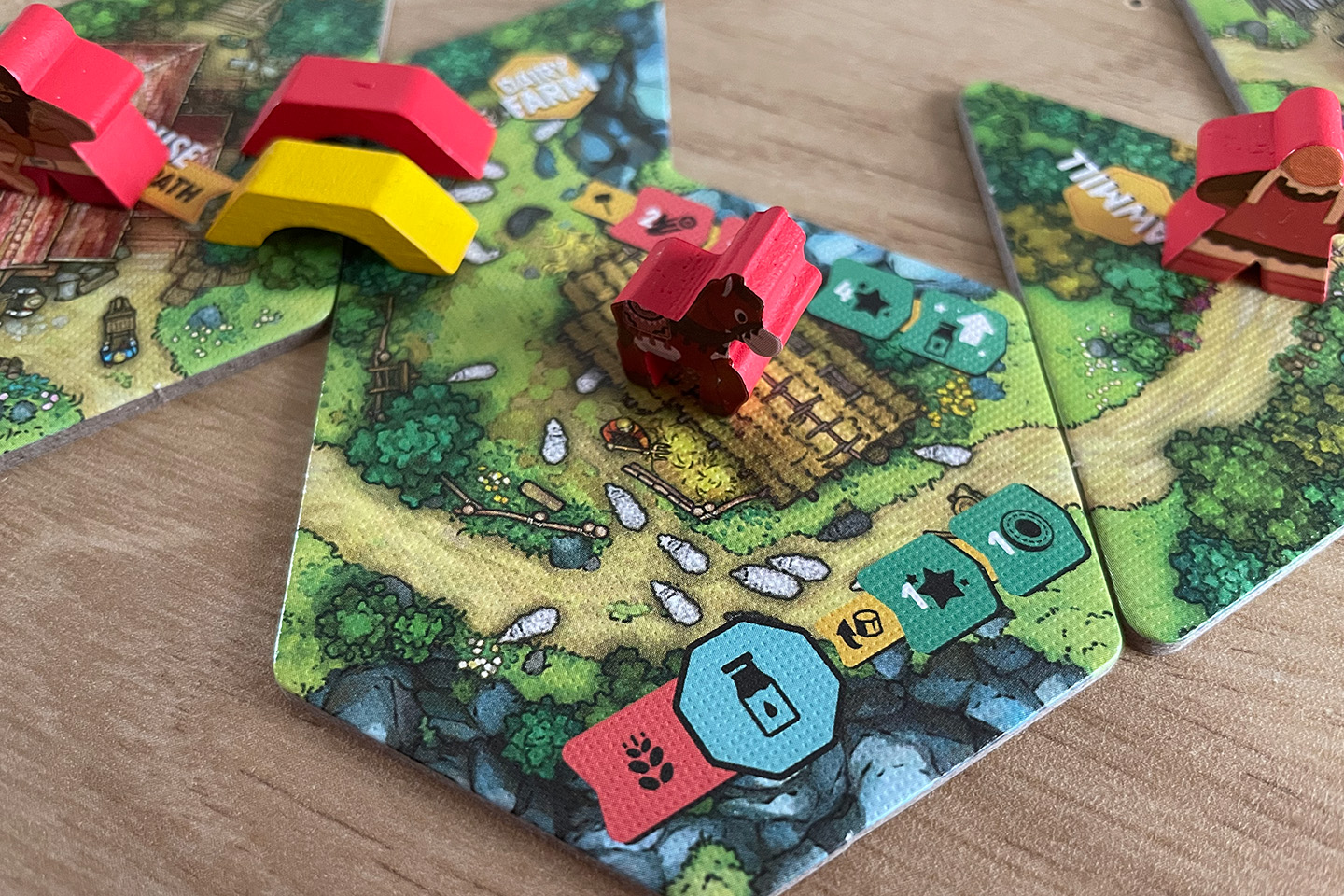
- Construct a road. While there are roads printed on the tiles, it’s not always possible to orient them in a way to align them on all adjacent tiles. If you need to transport materials to a tile that isn’t connected by a road, you can build one yourself. Such a road is called either a bridge if it connects two mountain edges or a path if it connects two forrest segments. A mountain segment touching a forrest segment cannot be connected by a road, so keep that in mind when you place tiles. Building a bridge costs two wood, building a path costs two stone, and as usual you need to be able to transport those materials to the tile your villager is on to build the road.
- Sell at the market. There are three market sale tiles on the market. These show materials at the top and rewards at the bottom. When you place a villager on the market you can make a market sale. If you can transport the materials on one of the tiles you take that tile along with the rewards on it. If there are still tiles in the market draw pile you take a tile and place it on the market. The market also serves a second purpose. If you ever need to pay materials that are not available, you can pay coins to “buy them from the market”. This costs your three coins per raw material and five coins per refined material. The only requirement is that you need to be able to transport these virtual materials from the market to the place where you need them. And you can of course not use this to make a market sale.


- Church actions. The main action you can take at the church is making a delivery. The church tile has four delivery spots which can be used once each: 10 coins, three milk and/or brick in any combination, three timber and/or flour in any combination and 10 wheat, wood and/or brick in any combination. When you have a villager at the church and you are able to make one of the deliveries you can place one of your discs on the delivery spot to indicate it is no longer available and you get the victory points associated with that spot. Once all four deliveries are done, the church is completed, your hamlet is now a town and the game ends after the current round has been finished. If you are completely out of options, and the quarry, woodcutter and farm are filled with their materials, you can take a begging action at the church with a villager. This gives you one coin.
This is how the game progresses. Everyone taking one of the above actions with every villager they have until all deliveries to the church have been made.
End game scoring can net a bunch of extra points. You get, for example, points for the landmark tiles and roads you have built. The game also has a few awards (most church deliveries, most market sales, …) which can give extra points.
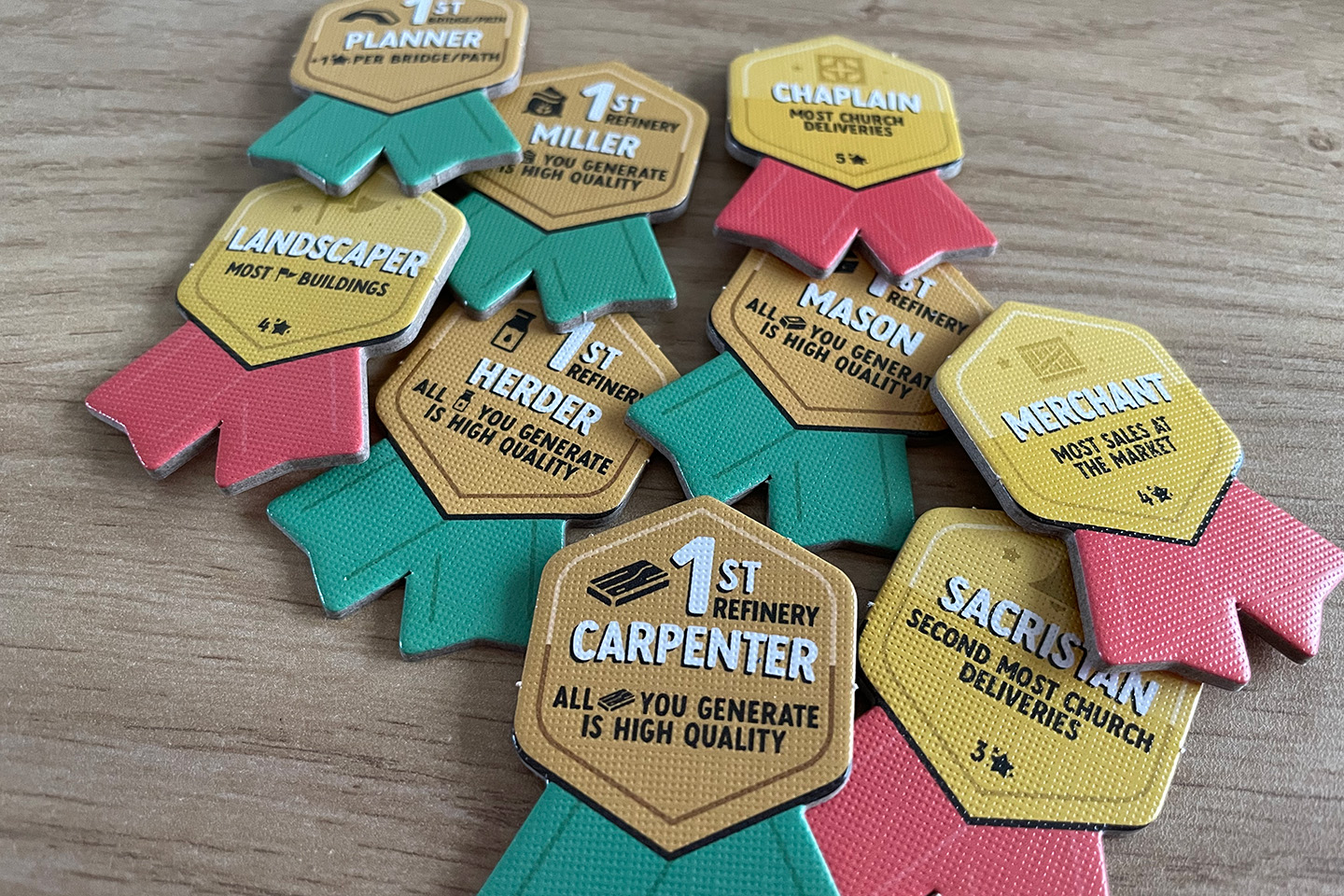
How does the AI work?
To set up a game against Botric you can pretty much follow the regular setup for a two player game; nothing changes for you.
For Botric’s setup you place his action board, shuffle the 5 action tokens and place them in a random order underneath the action board. The action board has a small cutout in the top-right. That’s where you need to place his favor token with two coins on top.
Next you need to determine Botric’s player color. Suppose you’re playing red and Botric is playing yellow. You take two of Botric’s yellow wooden discs, three green ones and four blue ones. One of the blue discs goes on the action board above the first action token, one of the green ones goes above the second action token and one of the yellow ones above the third action tokens. The remaining discs (three blue, two green and one yellow) go into a bag or a cup.
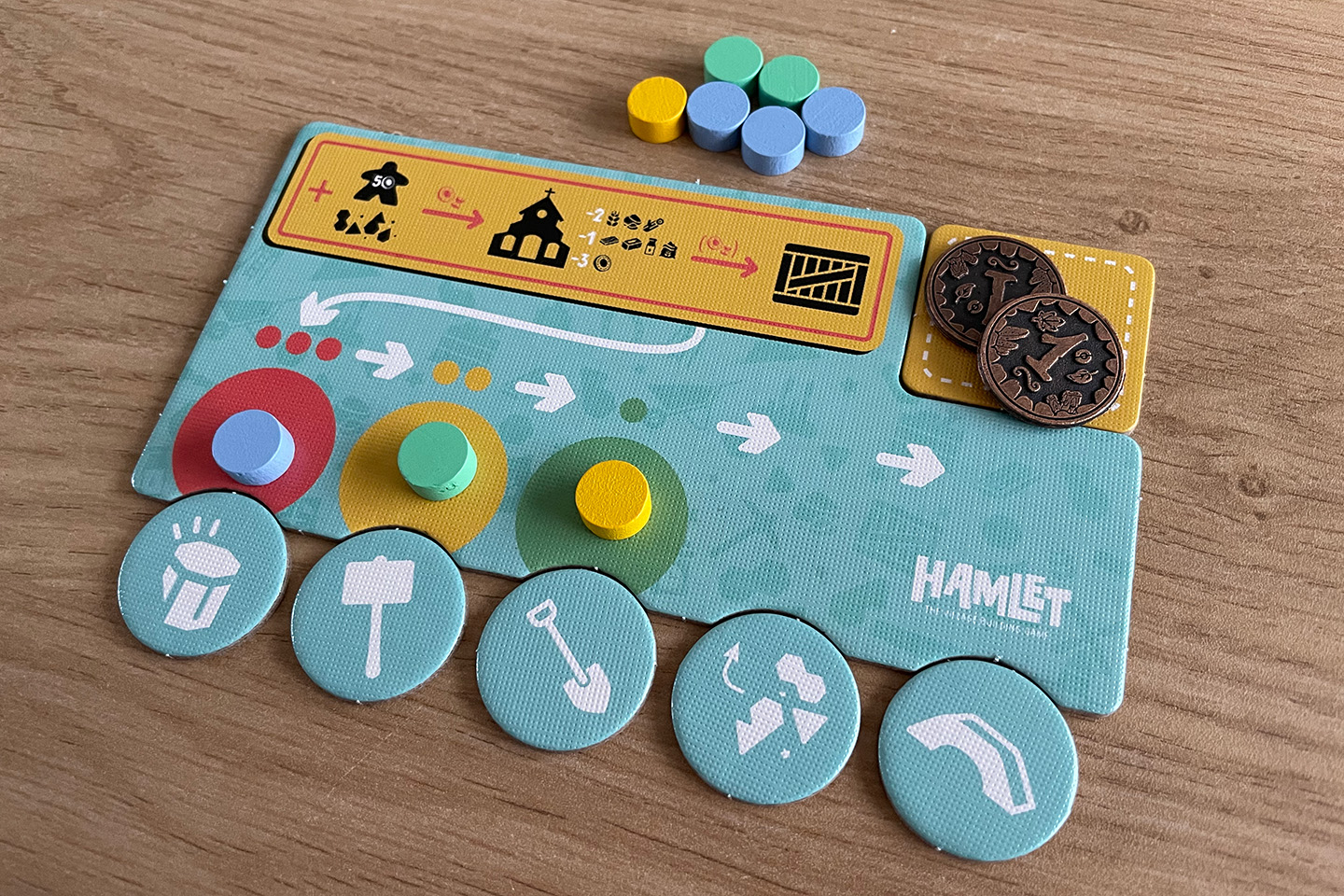
Botric, the AI opponent in Hamlet, functions almost like a human player, with a few exceptions:
- Botric does not use donkeys and can transport material from any tile to any other tile, as long as their connected via a road;
- Botric never uses the market to buy missing materials;
- When gaining coins from a bonus, a reward or when purchasing a blueprint with coins on it, Botric gains 1 victory point instead;
- All of Botric’s extra villagers cost them 5 coins instead of 5/7/9 coins for you;
- Botric gets a discount for church deliveries: 2 raw materials, 1 refined material and 3 coins.
On their turn, Botric takes an action with each of their villagers and for every villager you follow the same steps. You first look if Botric can take one of the three priority actions displayed at the top of Botric’s action board:
- Hire a villager. If there is at least 5 coins on Botric’s favor tile, they will return 5 coins to the supply and place a new villager, lying down to indicate it can’t take an action this turn, on the church tile.
- Make a church delivery. If Botric is able to make a church delivery, taking their discounts into account, they will do so.
- Make a market sale. If Botric is able to sell something to the market to claim one of the market tiles, they will do so.
If a villager did not take any of the three priority actions, you move on to the non-priority actions. To do this, you draw on of the colored discs from the bag or cup. You then check if Botric can take the action below that color on the action board. If they can’t, check the action to the right, moving further to the right, wrapping back around to the left, until you find an action Botric can take. In case you end up back where you started just lay down the villager on the church tile and place 1 coin on Botric’s favor tile. If Botric did take of the 5 actions, move that action token to the rightmost position and slide ones were on its right to the left to close the gap. Botric is now less likely to take this action.
I’ll quickly go over the 5 action tokens below the action board (from left to right based on the picture above) and explain what the action means for Botric.
- Refine. Botric will activate a refinery tile connected to the road network, with space left to refine on, that has the required materials available somewhere in the village.
- Construct a building. Botric constructs a building from their tile queue that they can afford to construct (only the required materials must be available in the village – Botric does not need to pay any coins!)
- Produce. Botric produces on the production tile with fewest materials remaining on it (that are not at their maximum), then gains 1 victory point (instead of the coin production reward).
- Take a blueprint. If Botric does not already have 3 tiles in their supply, they will purchase a new blueprint tile.
- Build a road. If the required materials are available, Botric builds a road.
For each of these actions you will need to make some decisions. Which production tile (quarry, farm, woodcutter, …) does Botric choose? Which blueprint will Botric buy? Which refinery will Botric select? Which building does Botric build and where to they place it? Across which two tiles does Botric build a road? The separate solo rulebook has priority queues for each these actions to help you make the correct decision.
When his cup or bag of discs is empty, simply put all used discs back in there, flip the favor token if it is face down and put an extra coin on there.
Apart from two changes, the end game scoring remains the same. So for you, nothing changes compared to a multiplayer game.
What does it look and feel like?
One of the things I like, is the way the game looks. Unfortunately, one of the things I do not like, is the way the game looks. Let me explain.
I really like the individual components in Hamlet. The tiles have fun shapes and beautifully detailed artwork and I find the color scheme (the shades of red, teal and yellow used throughout the game) very pleasing to the eye. The screen printed villagers and donkeys are adorable. The different wooden tokens that represent the materials are very nice as well, but maybe a bit small. And white printing on bright yellow tokens is a bad idea. But apart from that, they’re nice.
What I don’t like is how everything comes together. The printing and iconography on the tiles is pretty small and when there are two villagers, a donkey, three materials and two roads on a tile, it becomes really hard to figure out what the tile does or requires without having to lean forwards. This game requires a well lit room and pretty good eyesight.
Something I do appreciate is how every village will have a different structure when the game is over.
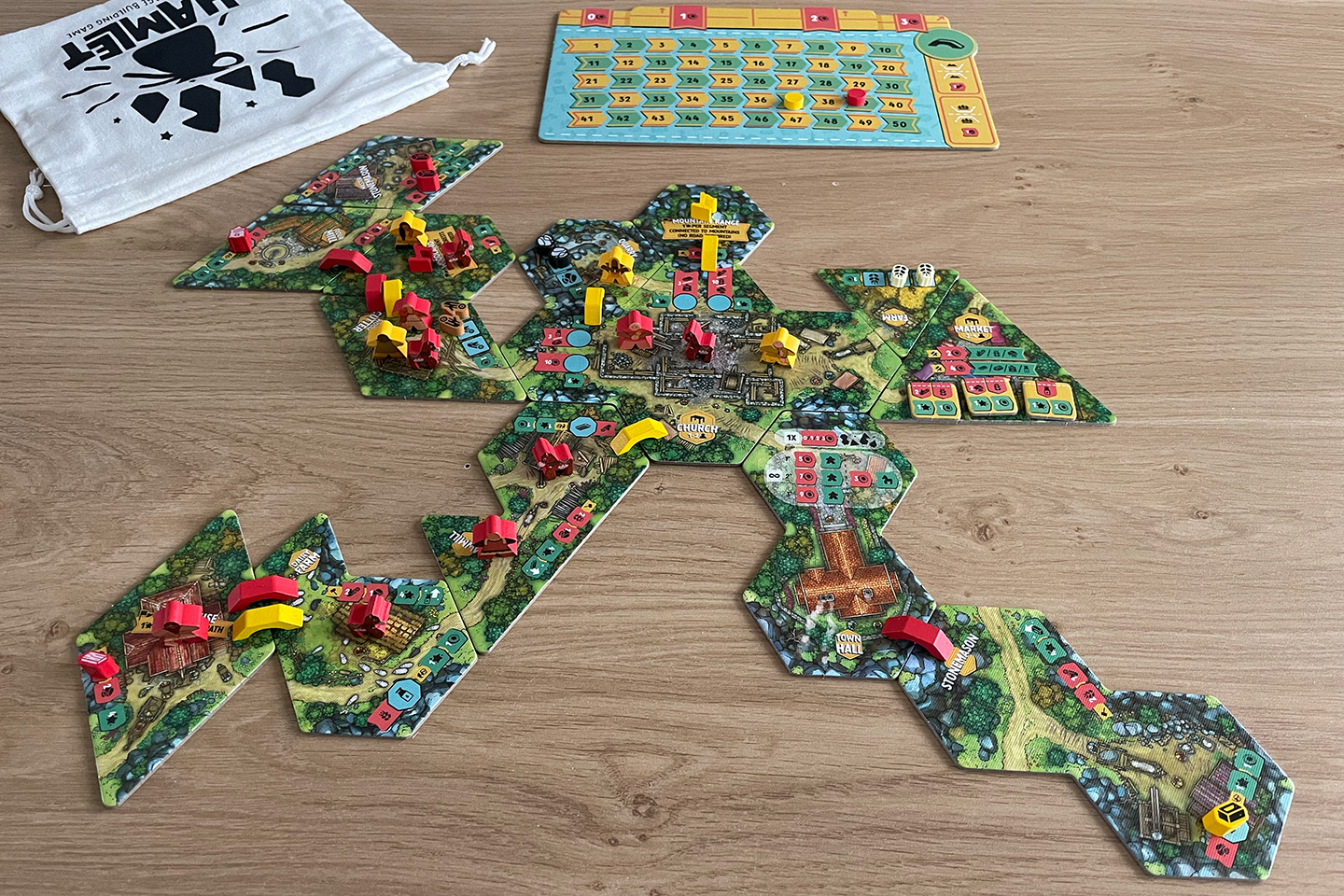
Finally a little word about the Deluxe Edition I got from Kickstarter. I don’t know all the differences between this version and the retail version, but I’m pretty sure the retail edition doesn’t come with the metal coins or the 3D church. If you’re into metal coins, you’re missing out. The ones that come with the Deluxe Edition are really nice. Not having the 3D church however, is nothing to be sad about. The seams don’t close nicely and it started coming apart after just a few hours. I never used it because it was, well, ugly, and it obscured parts of the board even more.
But apart from that 3D church, Hamlet is very good game quality wise.
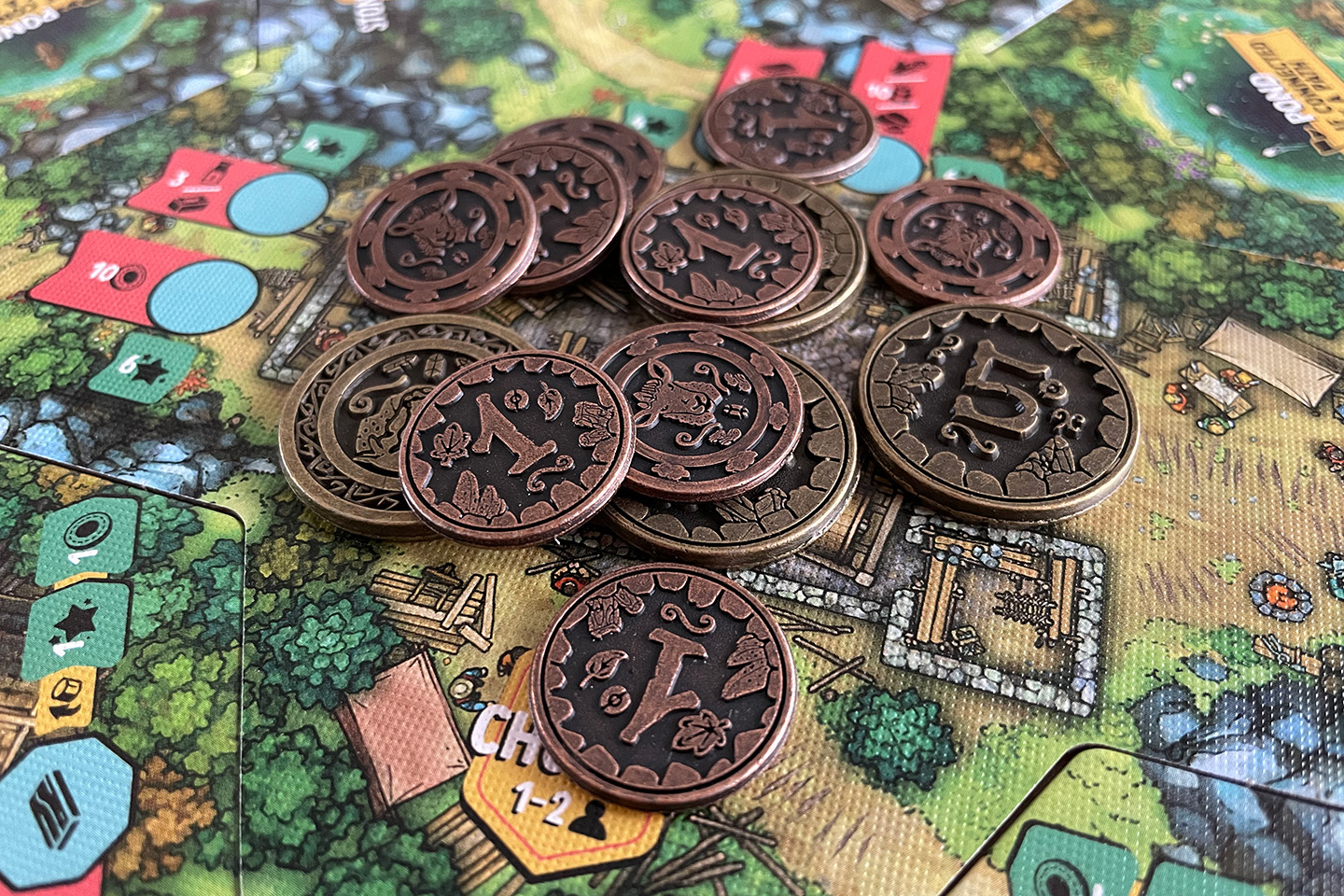

How much time does it take?
Thanks to the handy insert, setting the game up doesn’t take too long. I would say you’re done in about five minutes. Putting everything back in the box takes a bit longer because you have to sort all buildings into their correct spot. The basic ones go in the bag and there’s a slot in the insert to group all advanced buildings per refinery that unlocks them.
According to the box, the game takes about 60 to 90 minutes to play. My solo games always took me about two hours. Granted, I’m a bit of a slow player, but that wasn’t the only reason my games took that long. Botric uses a priority queue for some of its actions and I can’t for the life of me remember them, so I had to look things up in the rulebook quite often. The game can also get in a state where you are basically waiting for refineries of certain types of goods to get built. Botric prioritizes refineries when deciding which building to build, but if he can’t afford it he will happily spend materials on a different building. This can cause games to drag on while you’re just waiting for Botric to finally build the dairy farm so milk becomes available. Sure, you can use the market to buy materials you need that aren’t available on the board, but five coins per resource is pretty expensive and I rarely found myself in excess of money.
What is my verdict?
Hamlet has some fun or interesting concepts. The shared materials force you to be efficient during your turns. If you refine some wood and stone into timber and bricks so you can build one of your blueprints on your next turn, you are definitely taking some chances. There’s no guarantee Botric doesn’t scoop them up right before your eyes. You still get the rewards for Botric using the refined materials you have produced, but you’re no closer to getting that building built. So you have make your turns count and try to line up your villager actions to get the most of it yourself instead of helping your opponent. The tile placement also offers a puzzle from time to time. Some landmark tiles give you points for every matching segment for example. Do you place the sawmill close to the woodcutter or do you make use of its forest edges to get your landmark to score more points?
Unfortunately, all these things are overshadowed by the game’s shortcomings.
Every game of Hamlet I’ve played, I’ve felt that the game lasted way longer than it should have. Often I was just waiting for Botric to finally build that one basic refinery that has been stuck in his build queue for the past 7 turns. You could, for example, be waiting on the dairy farm so you could get access to milk and other more advanced tiles could get added to the bag. Until the refinery is there you could try saving up on money to buy milk at the market, but you really need your money to hire extra villagers and donkeys. In the meantime, Botric can just make use of their discounts to make church deliveries without needing access to milk while you are waiting for those refineries and saving money for the market. This really makes Hamlet overstay its welcome.
While all the tiles and components look great on their own, the way they get lumped together makes it all very hard to parse and quite fiddly. The small wooden tokens for the refined materials are not distinct enough for my tastes. Especially the timber and brick and the flour and milk have the same shape at first glance. Because of this, you really need to look carefully at each tile to see if the materials you require are available or not. You can’t just take a quick glance and have all the information you need. Trying to grab a single tiny material token from a tile filled with villagers, donkeys, roads and materials quickly gets overly fiddly. Was that villager on this tile or did I just accidentally push him over?
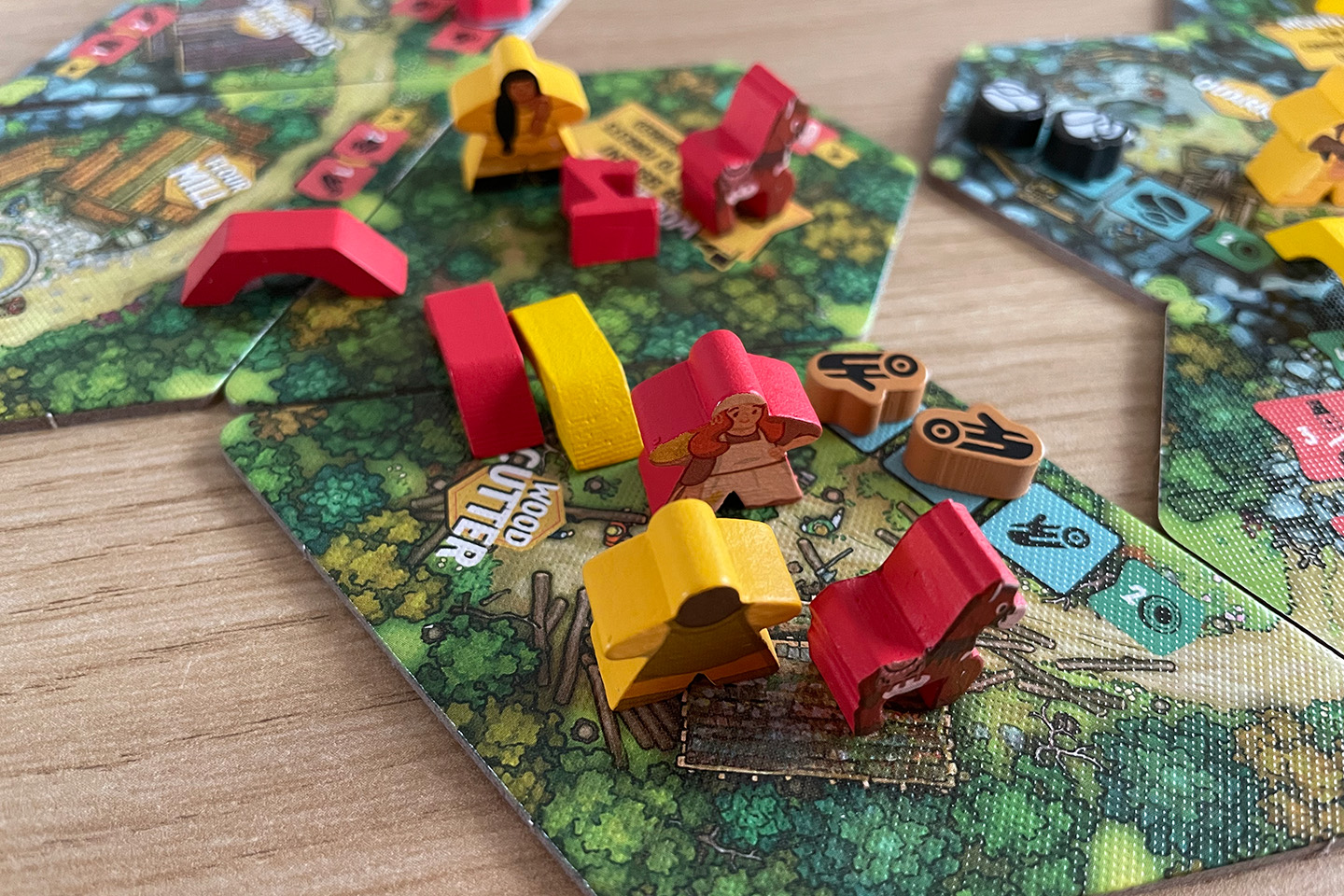
A final thing I didn’t like, and an important one in a solo game, is the solo mode. Every action Botric can take comes with some sort of priority queue or decision tree. This might just be me, but I am super bad at remembering things like this, so in every game I played, I was checking the rulebook for every one of Botric’s turns. You know what the worst part is? Most of these priority queues can be summarized as “make the smartest move Botric can do here”. So you either memorize all the decision trees, or you just come up with the best move for Botric. Which means you might as well play two handed, right? I do think Hamlet is not an easy game to make a solo mode for. The game is very open and sandboxy so you can’t have a solo mode that has you just flip a card and execute a simple action without having to think about it. I absolutely appreciate all the effort Nick Shaw and Dávid Turczi have put into the design of the solo mode, but unfortunately, it isn’t a solo mode I enjoy.
Just like the game itself, my review ended up being longer than I thought it would be and while, on paper, this game has a lot that I should like, it unfortunately fell rather flat for me pretty quickly, much like the 3D church.
Score
To make things easier for myself, I use the same scoring categories Board Game Geek uses.
Comments
I'm sorry, I don't support comments on my website. If you want to discuss the game or my review, feel free comment on this dedicated Instagram post or my review on BGG.